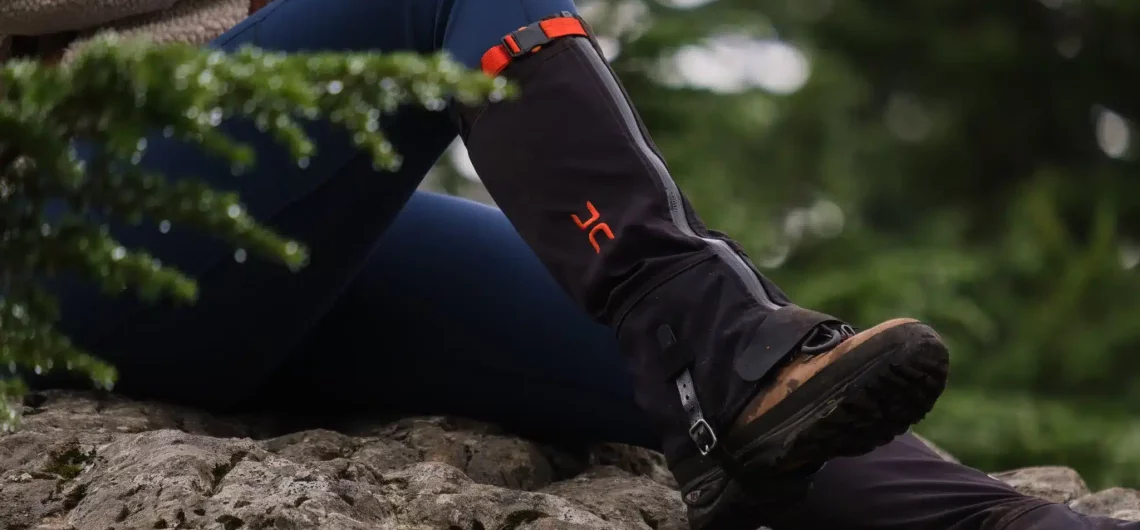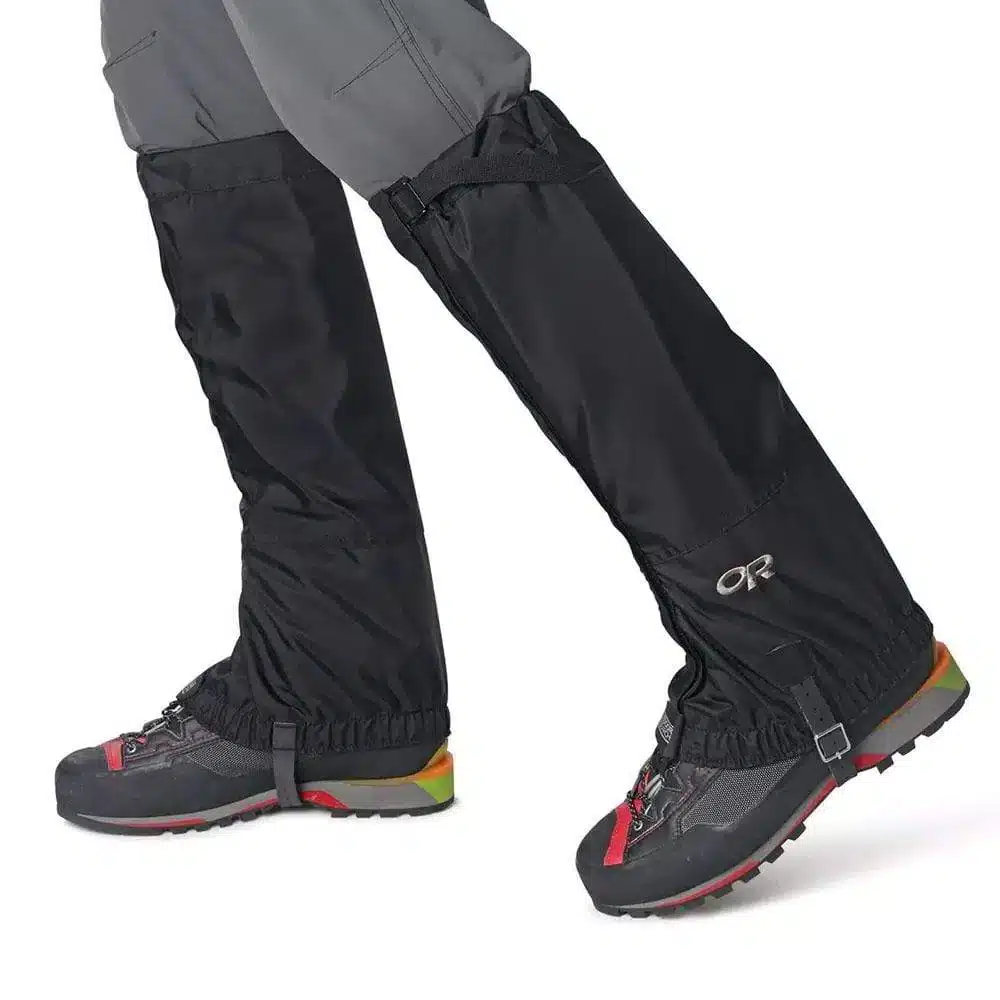Gaiters are sleeve-like covers made of cloth that go over the top of the boot, the ankle, and typically the lower leg as well. The primary purpose for which they are worn is to close the gap that exists between the pants and the boots, so preventing foreign objects from entering the footwear. This includes things like snow, rain, gravel, muck, soil, plant stuff, and anything else that you could come into touch with while hiking on the path. In addition, gaiters protect your lower legs from the cold by adding an extra layer of insulation and protecting against abrasions caused by rocks and thorns.
Gaiters provide more protection against the weather, which is an advantageous benefit on the mountain, even if their use is not strictly required. Gaiters are worn by an estimated twenty-five percent of climbers who take on Kilimanjaro. They are not required, but having them is a good idea, particularly on the summit night when there is a lot of scree (gravel) on the way and when temperatures can become quite high. Below are the recommended gaiters for climbing Kilimanjaro, Mount Kenya, Rwenzori Mountains, Mount Meru, and Ol Doinyo Lengai.
Read more about the best gaiter brands for climbing Kilimanjaro
Outdoor Research Rocky Mountain High Gaiters
These gaiters from Outdoor Research are built to last and feature a design that eliminates excess weight while yet providing water resistance and breathability. They have a velcro fastening on the front, a buckle clasp on top, and a hook for the boot laces.
There is a selling price of $45 for the Outdoor Research Rock Mountain High Gaiters. Shop here
 Outdoor Research Crocodile Gaiters
Outdoor Research Crocodile Gaiters
These gaiters are both waterproof and breathable, and they are full-length and strong-duty. They have a velcro fastening on the front, a buckle clasp on top, and a hook for the boot laces. If you plan on wearing trail shoes instead of hiking boots, you should select a gaiter with a different circumference than this one because it was designed for larger boots.
Outdoor Research creates the Crocodile Gaiter, which retails for close to $80 and can be purchased on their website. Shop here
 The following stores are your best bets for purchasing all of your camping and hiking equipment:
The following stores are your best bets for purchasing all of your camping and hiking equipment:
Choosing the Best Gaiters for Trekking:
Trekking across diverse landscapes demands reliable gear, and gaiters are a fundamental part of your kit, providing protection against debris, moisture, and environmental elements. Embarking on trekking adventures across diverse terrains like Kilimanjaro, Mount Kenya, Rwenzori, Mount Meru, and Ol Doinyo Lengai demands specialized gear, and gaiters play a crucial role in keeping you comfortable and protected. Here’s a comprehensive guide to help you choose the best gaiters for your trekking adventures:
1. Consider the Terrain:
- Mountainous Terrain: Opt for high gaiters with durable materials to shield against rocks and debris.
- Snowy Conditions: Choose waterproof and insulated gaiters to protect against snow, ice, and cold temperatures.
- Desert and Hot Climates: Lightweight, breathable gaiters with dust resistance are ideal for hot and arid conditions.
2. Material and Durability:
- Durable Materials: Look for gaiters made from tough, abrasion-resistant fabrics for longevity.
- Waterproofing: Gaiters with waterproof or water-resistant materials are crucial for wet conditions.
- Breathability: In warmer climates, prioritize breathable materials to prevent overheating.
3. Height and Coverage:
- Low Gaiters: Suitable for light trails and warmer conditions.
- Mid Gaiters: Provide extended coverage, ideal for varied terrains and climates.
- High Gaiters: Best for challenging terrains, offering maximum protection against rocks, snow, and debris.
4. Closure Systems:
- Front Closure: Easy to put on and take off, suitable for various conditions.
- Zipper Closure: Provides additional security against debris and snow, ensuring a snug fit.
5. Fit and Comfort:
- Snug Fit: Ensures gaiters stay in place and prevent debris from entering.
- Adjustable Straps: Allow for a customizable and comfortable fit around your boots and legs.
6. Ventilation:
- Breathable Panels: Important for warmer conditions to prevent overheating.
- Vents or Zippers: Enhance airflow and comfort during strenuous treks.
7. Additional Features:
- Boot Compatibility: Ensure compatibility with your trekking boots.
- Instep Straps: Keep gaiters securely in place over your boots.
- Reinforcements: Extra layers in high-wear areas for added durability.
- Reflective Elements: Enhance visibility in low-light conditions for safety.
8. Brand Reputation and Reviews:
- Research Brands: Choose reputable brands known for quality outdoor gear.
- Read Reviews: Gather insights from other trekkers’ experiences with specific gaiter models.
9. Budget Considerations:
- Balancing Quality and Cost: Invest in durable, reliable gaiters within your budget.
- Long-Term Value: Consider gaiters as a long-term investment in your trekking gear.
10. Seasonal Considerations:
- Winter Trekking: Insulated, waterproof gaiters are essential.
- Summer Trekking: Lightweight, breathable gaiters with dust protection are ideal.
Choosing the best gaiters for trekking involves a thoughtful consideration of the specific conditions you’ll encounter. Whether navigating rocky trails, snowy slopes, or dusty paths, selecting gaiters tailored to your trekking needs ensures a more comfortable and enjoyable outdoor experience. Always check for updated gear recommendations and ensure your gaiters align with the demands of your chosen trekking destinations.
Gaiter Anatomy and components

1. Top Closure:
- Purpose: The top closure is located at the upper end of the gaiter, typically around the calf or just below the knee.
- Function: It ensures a secure fit around your leg, preventing debris, snow, or water from entering the top of the gaiter.
- Common Types: Elasticized tops, drawstring closures, or hook-and-loop fasteners are common closure mechanisms.
2. Front Closure:
- Purpose: The front closure runs along the front of the gaiter, allowing for easy putting on and taking off.
- Function: It provides accessibility while maintaining a secure fit, often using zippers, snaps, or hook-and-loop closures.
3. Instep Strap:
- Purpose: Located under the foot, the instep strap helps secure the gaiter in place over the instep of your boot.
- Function: It prevents the gaiter from riding up or shifting during movement, ensuring continuous protection.
4. Boot Lace Hook or Ring:
- Purpose: Positioned at the bottom of the gaiter, near the instep, a hook or ring attaches to the laces of your boot.
- Function: This feature further secures the gaiter, preventing it from slipping down and maintaining a snug fit.
5. Front Closure Cover (Storm Flap):
- Purpose: The storm flap is an additional layer covering the front closure.
- Function: It adds protection against moisture and debris, enhancing the gaiter’s weather-resistant capabilities.
6. Material and Construction:
- Materials Used: Gaiters are typically made from durable and weather-resistant fabrics such as Cordura, Gore-Tex, or other nylon blends.
- Reinforcements: High-wear areas, like the inner leg, often feature reinforced panels for added durability.
7. Straps and Adjustability:
- Adjustable Straps: Gaiters commonly feature straps with buckles or hook-and-loop fasteners for customization.
- Underfoot Straps: Some gaiters have straps that pass under the boot to enhance stability.
8. Ventilation:
- Breathable Panels: Gaiters may include sections made of breathable materials or have built-in vents to prevent overheating during strenuous activities.
9. Reflective Elements:
- Placement: Reflective strips or elements are often incorporated into gaiter design.
- Purpose: They enhance visibility in low-light conditions, improving safety during dawn, dusk, or nighttime treks.
Understanding the anatomy of gaiters allows outdoor enthusiasts to make informed decisions when selecting the right pair for their specific activities. Whether hiking, trekking, or mountaineering, the proper fit and features of gaiters contribute to a more comfortable and protected outdoor experience.
![]()



Comments